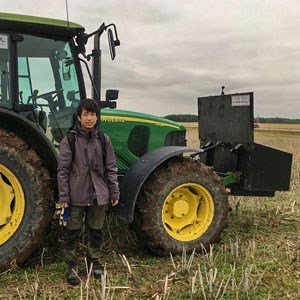Contact
Jumpei Fukumasu
Department of soil and environment, SLU
jumpei.fukumasu@slu.se, 018-67 24 56, 0722-36 17 39

How does organic carbon in the soil, the structure of the soil and different physical processes affect each other? These are factor are important to understand water dynamics and if the soil will leach pesticides and fertilizers. Jumpei Fukumasu has investigated this in an agricultural topsoil his new doctoral thesis.
Soil is a porous medium and has, like a sponge, a large variety of pore sizes.
– In agricultural systems, understanding of water dynamics in relation to soil structure, for example the spatial arrangement of solids and pores, is important as water carries agrochemicals, such as chemical fertilizers and pesticides, says Jumpei.
If these agrochemicals are leached out of the crop root zone to, for example, groundwater and ditches around agricultural fields, they can be harmful to aquatic organisms and make groundwater unsuitable for human consumption. We therefore need to know what a good soil pore structure is, both for crop production and for water quality management.
The storage of carbon in soils is larger than the storage in plant biomass and in the atmosphere combined. Most carbon in soil is present as organic carbon. Large amounts of soil organic carbon have been depleted from arable soils and released into the atmosphere as carbon dioxide due to historical intensive agriculture. It is therefore important to know how to increase soil organic carbon content in arable soils, which can then help regulate our future climate.
– In my thesis, I examined how soil organic carbon was stored and how it interacted with soil mineral constituents for arable topsoils. I then investigated relationships between soil organic carbon and soil pore structure, water flow and solute transport, says Jumpei.
A large proportion of soil organic carbon (80%) was present in the silt- and clay-sized fraction of the soil which indicated that most soil organic carbon was physicochemically protected against microbial decomposition. This stabilization seemed to be governed by reactive aluminum.
– On the other hand, clay content and reactive iron, which are both known to be important for soil organic carbon stabilization, did not seem important in the Bjertorp field. In addition to these mineral constituents, there was a large variation in crop productivity across the field, which possibly caused a spatial variation in carbon input from crop roots. This variation partly explained the spatial variation in soil organic carbon content, says Jumpei.
Soil pore size distributions were quantified using X-ray tomography and soil water retention measurements.
– I found that soil texture (clay content) had a stronger impact than soil organic carbon content on pore structure. However, I also found a relatively large increase of soil pore abundance in the 0.2–5 and 480–720 µm diameter ranges with an increase in soil organic carbon content. This suggested that soil organic carbon sequestration in arable topsoils is potentially beneficial for the water supply to plants and for soil infiltration capacity.
Laboratory experiments were conducted to evaluate the risk of fast solute transport in soil macropores and its relationship with soil pore structure and soil properties.
– The risk for fast transport was smaller with larger abundance of mesopores and small macropores (30–480 µm diameter ranges), whereas the abundances of large macropores (>720 µm diameter range) and their networks (i.e. how macropores were connected through the soil) had limited effects on the risk of preferential transport. I could not find any positive effects of soil organic carbon content on the risk of fast transport. This was possibly due to the much stronger effects of clay content, concludes Jumpei.
To assess the effects of soil organic carbon on preferential transport, further studies will be needed using soils with a smaller variation in clay content.
Jumpei Fukumasu
Department of soil and environment, SLU
jumpei.fukumasu@slu.se, 018-67 24 56, 0722-36 17 39
Read Jumpei Fukumasu´s doctoral thesis “Relations between soil organic carbon, soil structure and physical processes in an agricultural topsoil - The role of soil mineral constituents”
Jumpei Fukumasu defends his thesis "Relations between soil organic carbon, soil structure and physical processes in an agricultural topsoil : The role of soil mineral constituents" on 17th February 2022. All interested are welcome to take part in the public defense on line. Read more about Jumpei Fukumasu's defense here.